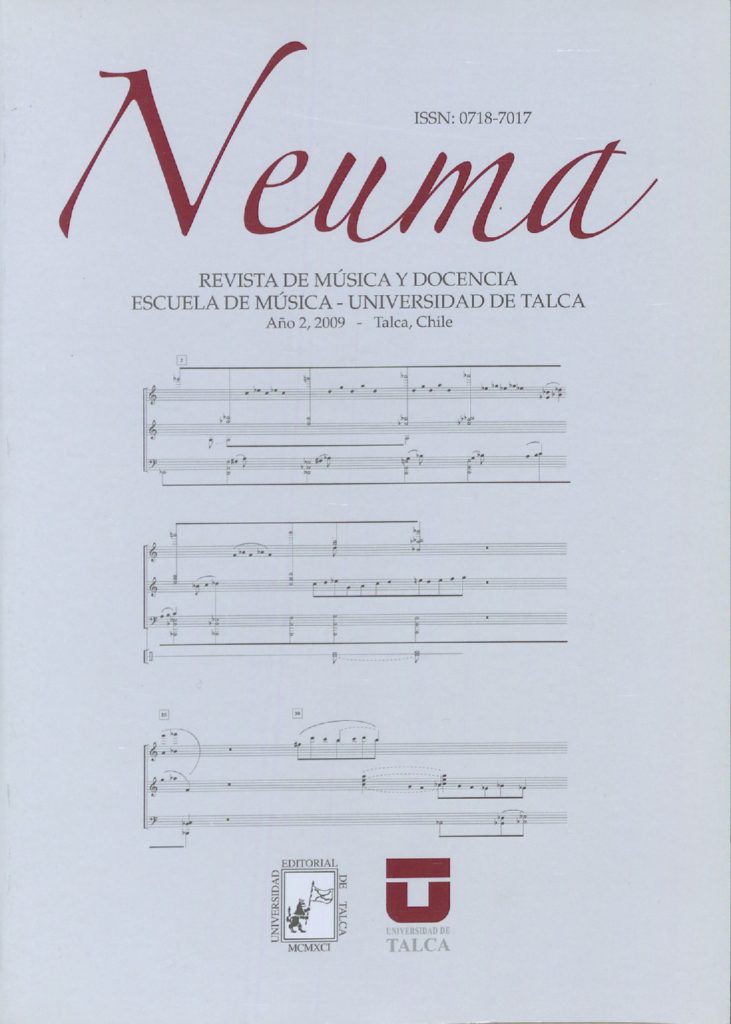Abstract
Using metaphor as a pedagogical tool for Music Education in infant stages has become increasingly intuitive and common in schools. Cognitive Sciences have generated models to underline the processes behind metaphorization such as Mark Johnson’s Embodied Mind. This theory deals with the image schemata underlying these metaphorical projections. This article analyzes some of the most frequently used bodily metaphors through the study of the image schemata involved in them, as a way to understand abstract domains in terms of others more concrete and structured.
References
Acevedo, I. (2005). “Metaphors in mathematics classrooms : Analyzing the dynamic process of teaching and learning to graph function”, Proc. CERME 4, http://ermeweb.free.fr/CERME4/
Bartlett, F. (1932). Remembering. Cambridge: Cambridge University Press.
Bernal, J. y Calvo, M.L. (2000). Didáctica de la música. La expresión musical en la educación infantil. Málaga: Ediciones Aljibe.
Bills, C. (2003). “Metaphor in young children’s mental calculation”, Proc 4th CERME, http://ermeweb.free.fr/CERME4/.
Brower, C. (2000). “A Cognitive Theory of Musical Meaning”. Journal of Music Theory 44 (2). pp. 323-379.
Cox, A. (1999). The Metaphoric Logic of Musical Motion and Space. Ph. D. Dissertation. University of Oregon.
Cox, A. (2003). “Metaphor theory’s leap of faith: From embodied experience to asbstract thought”. Proceedings of the International Conference Music and Gesture. Norwich, 28-31 August 2003.
Dirven, R. (1994). “Metaphor and nation: metaphors Afrikaners live by”. Duisburger Arbeiten zur Sprach und Kulturwissenschaft, 22. Frankfurt am Main: P. Lang.
Echard, W. (1999). “An Analysis of Neil Young’s ‘Powderfinger’ based on Mark Johnson’s Image Schemata”. Popular Music 18 (1). pp. 133-144.
Echard, W. (2003). “Plays guitar without any hands: Musical movement and problems of immanence”. Proceedings of the International Conference Music and Gesture. Norwich, 28-31 August 2003.
Eco, U. (1981). Lector in fabula. Barcelona: Lumen. (1ª edición 1979).
Feld, S. (1981). “Flow like a Waterfall: the metaphors of Kaluli Musical Theory”. Yearbook for Traditional Music 13. pp. 22-47.
Gibson, J. (1979). The Ecological Approach to Visual Perception. Boston: HoughtonMifflin.
Head, H. (1920). Studies in neurology. Oxford: Oxford University Press.
Johnson, M. (1987). The body in the Mind. Chicago: University of Chicago Press.
Kittay, E. F. (1987). Metaphor: Its Cognitive Force and Linguistic Structure. Oxford: Oxford University Press.
Lakoff, G. (1996). Moral Politics. Chicago: University of Chicago.
Lakoff, G. y Johnson, M. (1980). Metaphors We Live By. Chicago: University of Chicago Press.
Lakoff, G. y Johnson, M. (1999). Philosophy in the Flesh: The Embodied Mind and Its Challenge to Western Thought. New York: Basic Books.
Lakoff, G. y Núñez, R. E. (2000). Where Mathematics Comes From: How the Embodied Mind Brings Mathematics into Being. New York: Basic Books.
Marconi, L. (2001). “Música, semiótica y expresión: la música y la expresión de las emociones”. Vega, M. y Villar Taboada, C. (eds.). Música, lenguaje y significado. Valladolid: Glares y Universidad de Valladolid-SITEM. pp. 163-180.
Martínez, I.C. (2004). “La prolongación como metáfora cotidiana. Hacia un modelo cognitivo idealizado de las estructuras prolongacionales en la música”. Universidad Nacional de La Plata. IV Reunión Anual de SACCoM, realizada los días 14 y 15 de Mayo de 2004 en el Instituto Superior de Música de la Universidad Nacional de Tucumán.
Minsky, M. (1975). “A framework for representing knowledge”. WINSTON, Patrick (ed.). The Psicology of computer vision. New York: McGraw-Hill.
Nubiola, J. (2000). “El valor cognitivo de las metáforas”. Pérez-Ilzarbe, P. y Lázaro, R. (eds.). Verdad, bien y belleza. Cuando los filósofos hablan de los valores, Cuadernos de Anuario Filosófico n° 103, Pamplona, 2000, pp. 73-84.
O’Regan, J. K. y Noë, A. (2001a). “A sensorimotor account of vision and visual consciousness”. Behavioral and Brain Sciences, 24(5), 2001. pp.883-917.
O’Regan, J. K. y Noë, A. (2001b). “What it is like to see: A sensorimotor theory of perceptual experience”. Synthese, 2001, 129, 1. pp. 79-103.
Peñalba, A. (2005). “El cuerpo en la música a través de la Teoría de la Metáfora de Johnson: análisis crítico y aplicación a la música”. Revista Transcultural de Música, Transcultural Music Review, vol. 9.
Peñalba, A. (2008). El cuerpo en la interpretación musical. Un modelo teórico basado en las propiocepciones en la interpretación de instrumentos acústicos, hiperinstrumentos e instrumentos alternativos. Publicaciones digitales: Universidad de Valladolid.
Piaget, J. [1926] (1973). La representación del mundo en el niño. Madrid: Morata.
Saslaw, J. (1996). “Forces, containers and Paths: the role of the body derived image schematas in the conceptualization of Music”. Journal of Music Theory 40/2. pp. 217-243.
Schank, R. y Abelson, R. P. (1988). Guiones, planes, metas y entendimiento. Barcelona: Gedisa. (1ª edición 1977).
Schön, D. A. (1979). “Generative metaphor: A perspective on problem-setting in social policy Metaphor and Thought”. Searle, J. R. (ed). Metaphor, in Metaphor and Thought. Cambridge: Cambridge University Press 1979-1993
Spitzer, M. (2004). Metaphor and Musical Thought. Chicago: University of Chicago Press.
Thaut, M. (1990). “Neuropsychological processes in music perception and their relevance in music therapy”. unkefer (ed.). Music therapy in the treatment of adults with mental disorders. New York: Schirmer.
Van Dijk, T. A. (1984). Texto y contexto. Semántica y pragmática del discurso. Madrid: Cátedra.
Varela, F. (1988). Conocer. Las ciencias cognitivas: tendencias y perspectivas. Cartografía de las ideas actuales. Barcelona: Gedisa.
Wuytack, J. (1992). Cantar y descansar. Canciones con gestos. Madrid: Real Musical.
Zbikowski, L. M. (1997). “Conceptual Models and cross-domain Mapping. New perspectives on theories of music and hierarchy”. Journal of Music Theory, 41/ 2, fall issue.

This work is licensed under a Creative Commons Attribution-NonCommercial 4.0 International License.
Copyright (c) 2009 Neuma (Talca)


